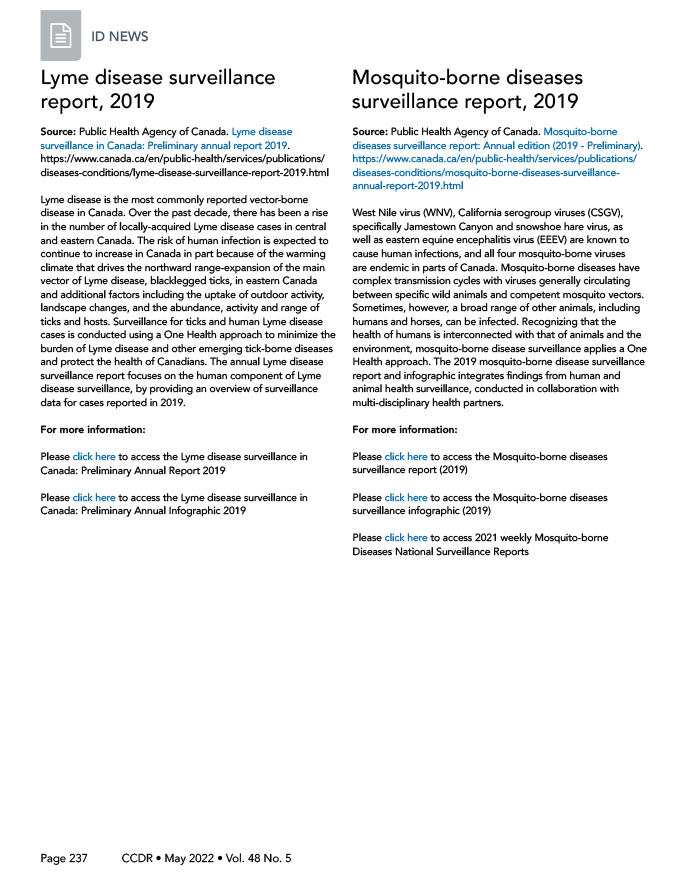Lyme and mosquito-borne disease surveillance reports, 2019

 Download this article as a PDF
Download this article as a PDFPublished by: The Public Health Agency of Canada
Issue: Volume 48-5, May 2022: Vector-Borne Infections–Part 1: Ticks & Mosquitoes
Date published: May 2022
ISSN: 1481-8531
Submit a manuscript
About CCDR
Browse
Volume 48-5, May 2022: Vector-Borne Infections–Part 1: Ticks & Mosquitoes
ID News
Lyme disease surveillance report, 2019
Source: Public Health Agency of Canada. Lyme disease surveillance in Canada: Preliminary annual report 2019. https://www.canada.ca/en/public-health/services/publications/diseases-conditions/lyme-disease-surveillance-report-2019.html
Lyme disease is the most commonly reported vector-borne disease in Canada. Over the past decade, there has been a rise in the number of locally-acquired Lyme disease cases in central and eastern Canada. The risk of human infection is expected to continue to increase in Canada in part because of the warming climate that drives the northward range-expansion of the main vector of Lyme disease, blacklegged ticks, in eastern Canada and additional factors including the uptake of outdoor activity, landscape changes, and the abundance, activity and range of ticks and hosts. Surveillance for ticks and human Lyme disease cases is conducted using a One Health approach to minimize the burden of Lyme disease and other emerging tick-borne diseases and protect the health of Canadians. The annual Lyme disease surveillance report focuses on the human component of Lyme disease surveillance, by providing an overview of surveillance data for cases reported in 2019.
For more information:
Please click here to access the Lyme disease surveillance in Canada: Preliminary Annual Report 2019
Please click here to access the Lyme disease surveillance in Canada: Preliminary Annual Infographic 2019
Mosquito-borne diseases surveillance report, 2019
Source: Public Health Agency of Canada. Mosquito-borne diseases surveillance report: Annual edition (2019 - Preliminary). https://www.canada.ca/en/public-health/services/publications/diseases-conditions/mosquito-borne-diseases-surveillance-annual-report-2019.html
West Nile virus (WNV), California serogroup viruses (CSGV), specifically Jamestown Canyon and snowshoe hare virus, as well as eastern equine encephalitis virus (EEEV) are known to cause human infections, and all four mosquito-borne viruses are endemic in parts of Canada. Mosquito-borne diseases have complex transmission cycles with viruses generally circulating between specific wild animals and competent mosquito vectors. Sometimes, however, a broad range of other animals, including humans and horses, can be infected. Recognizing that the health of humans is interconnected with that of animals and the environment, mosquito-borne disease surveillance applies a One Health approach. The 2019 mosquito-borne disease surveillance report and infographic integrates findings from human and animal health surveillance, conducted in collaboration with multi-disciplinary health partners.
For more information:
Please click here to access the Mosquito-borne diseases surveillance report (2019)
Please click here to access 2021 weekly Mosquito-borne Diseases National Surveillance Reports
